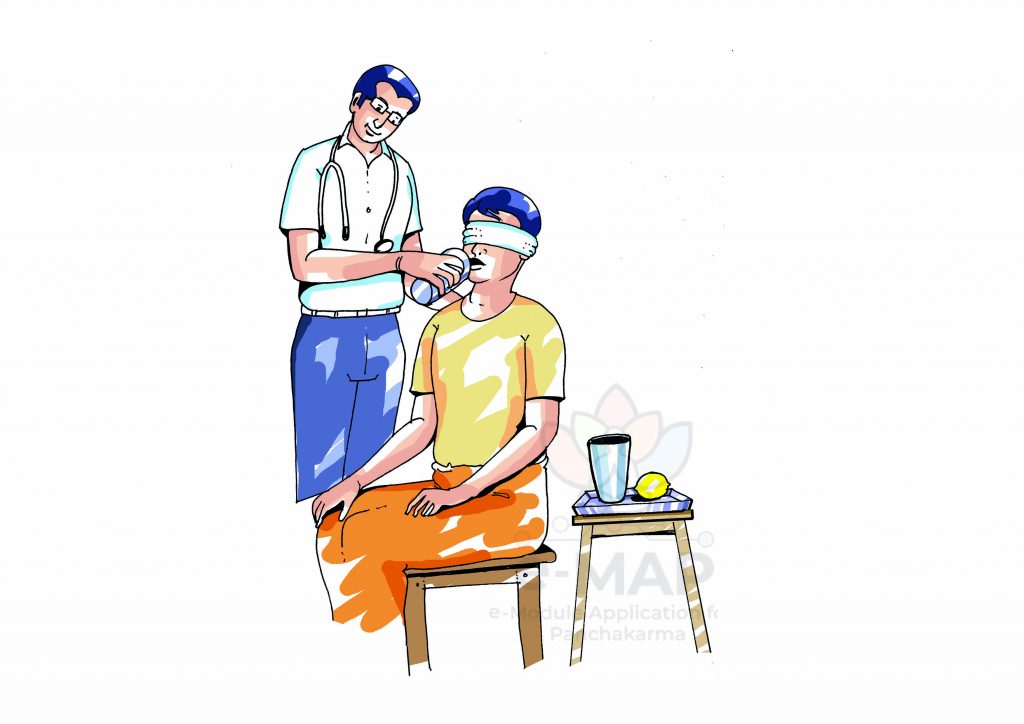
Basic Module 2 - Lesson 17
SNEHANA

EXPLANATORY NOTES
Lesson 18
TAKRADHĀRA:
Takra dhāra is a variety of śirodhāra, in which medicated buttermilk is poured in a continuous stream over the forehead, in a specified manner.
Materials Required:
- Śirodhāra device -1
- Vessels-3 (To prepare takra; to prepare Āmalaki kvātha; to take out takra from
droṇi)
- Towels: 3
- Cotton plugs: 2
- Gauze piece(60 cm): 2
- Āmalaki Cūrṇa: 200g
- Milk: 1.5 litres
- Musta: 100g
- Oil for Talam: 10 ml
- Rāsnādi Cūrṇa: 5 g
- Attendents-2
Preparation of the medicine:
- a) Takra: 1.5 litres of milk diluted with 4 times water is boiled with 100g of skinned and crushed Musta tied in a muslin bag, and is reduced to the original quantity of milk. The bag of medicament is taken out and squeezed well. When cooled, this prepared milk is fermented by the addition of a little sour buttermilk overnight. Next morning the fermented medicated curd is churned by adding 500ml of Āmalaki kvātha. The butter is
removed completely and this mixture is used for dhāra after filtering.
- b) Āmalaki kvātha: 200g of dried Āmalaki fruit boiled with 8 litres of water and reduced to 2 litres.1.5 litres of Āmalaki kvātha is used to mix with buttermilk & 500ml of that is used to wash the head after the procedure.
Pre-operative measures:
Since it is done as a Śamana therapy no Pūrva karma is needed. The application of oil on
the head and body is usually done as a practice. Suitable oils according to roga are selected
by the physician for this purpose. The eyes should be covered with eye pads and gauze should be tied around the head above the eyebrows. The ear should be plugged
with two cotton pieces.
Procedure:
The patient should lie in supine position on the droṇi. A small pillow should be placed under the neck. The dhāra pot should be kept in such a way as to allow steady flowing of the liquid, poured into it, over the forehead of the patient. The tip of dhāravarti should be 4-5 cm above the forehead of the patient and total wick length should be 8-10cm. The takra falling should be poured again into the vessel after collecting it from the droṇi. The vessel should always be kept oscillating so that the takra will fall into the patient’s entire forehead without interruption.
Duration:
The process should be done daily for a period of 7 to 14 days. The duration of treatment as well as the time period is according to the nature of the disease and the physical condition of the patient. It is done usually for a fixed time (45minutes to 1 hour).
Post-operative procedure:
After the dhāra, the head is washed with Āmalaki kvātha. Then the head should be wiped with a towel and Rāsnādi cūrṇa is applied. Patient is advised to take rest for a period same as the period of the procedure, then to take a bath.
Complications and management:
Shivering is observed in some patients due to excess śīta. In such case the
procedure is stopped immediately and the patient is managed with uṣṇopacāra.
ŚIROLEPA
Introduction:
Application of medicated paste over the head completely covering the scalp is called śirolepa.
Method:
Pūrvakarma:
- Preparation of medicine: 1 kudava (192gm) dry āmalaki without seed is boiled with 2 kudava of takra. Boil till the water gets evaporated.
- Preparation of patient: Śiro abhyaṅga should be done.
Pradhāna karma:
- The prepared medicine should be first applied at the center of the head, then over the front, sides and back of the head.
- Thickness: 1 aṅgula
- The head should be covered with banana leaf or lotus leaf.
- Duration: 1 ½ hours or 48 minutes.
Paścāt karma:
- At the end of the procedure the lepa is wiped off and śiro abhyaṅga can be done.
Benefit:
- Beneficial in क्लम, अपचि and it increases दृष्टिबल, it gives सुख निद्रा.



